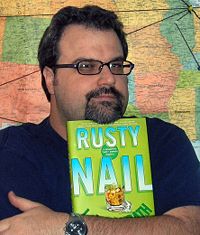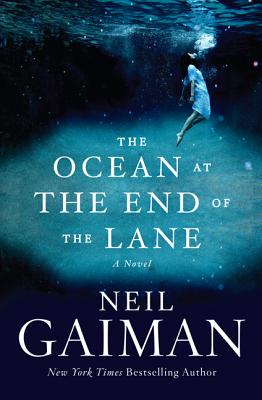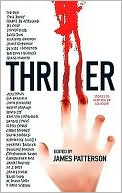This is me.
It's a self-portrait I shot in a hotel room mirror a few days ago. No, no I was not wearing any pants, but that's neither here nor there. It was Sunday morning, after
Thrillerfest, and I'd been up past 4:00am the night before. 'Nuff said.
Please note the t-shirt I'm modeling. It has a few signatures on it. It is my memento from Thillerfest VIII in New York. And I have one t-shirt like this for each of the eight years that the conference has been in existence. This is the story of how the tradition started.
It was the first day of the very first Thrillerfest in Phoenix, way back in 2006. I already had a few friends in the thriller community. (I'd actually been at the party at the Algonquin Hotel a year earlier where
ITW, and hence Thrillerfest, was born.) Nothing was really scheduled to begin until late afternoon, and so I agreed to join my friend
J.A. "Joe" Konrath to sign stock at a couple of bookstores. That's a whole story in and of itself.
I actually accompanied Joe on the first two stops of his insane 600-store book tour for Rusty Nail. Was he grateful for my company as he embarked on this epic journey? I don't think so. I recall him snarling, "Flap faster, Susan, faster!" That was at the renowned
Poisoned Pen Bookshop. After that, we were joining some other ITW authors at a Walmart somewhere in Phoenix. They were promoting
the first Thriller story collection.
 |
| Joe Konrath plots his book tour. |
There were quite a few big-name authors all sitting at a table, filled with books just waiting to be signed. When Joe and I walked up, they were all alone. I know that
James Rollins,
Steve Berry, and
David Liss were there.
Gayle Lynds was supposed to be there, but she was feeling unwell, and I actually wound up in her seat. And I could swear that there was one other author present, but for the life of me I can't remember who it was. Isn't that awful?
This is what I do remember: no one would come near the signing table. Here were all these best-selling authors, and in the words of a boss I once had--they couldn't sell sex to a sailor. In the course of about two hours they sold and signed maybe two or three books. And that was with the added inducement of a free t-shirt! It was truly pathetic. At some point, one of them handed me a t-shirt and said,
"Here, we'll sign this for you." They were desperate to sign anything by that time. And
that is the moment this tradition started.
After the signing, I bailed on Konrath and hopped into the back of a limo with Rollins, Berry, and Liss to head back to the Biltmore and the official start of Thrillerfest. It was where I had the first of many arguments with David Liss, who I'd just met. Good times! Eight years later, we're still at it. It's how we express affection for each other.
Once the conference got going, there were
so many awesome writers in attendance, it seemed
 |
| David Liss |
like a good idea to have them
all sign the t-shirt. As I've said countless times in the years since,
"It weighs a hell of a lot less than schlepping everyone's books back and forth from California." I had a spare Thriller t-shirt I used for the same purpose the following year in New York, and I've bought a cheap t-shirt on the street every year since.
I'm one of a dwindling number of individuals who have never missed a T-Fest in the conference's history. The t-shirt is my memento of each year's conference. It gives me an excuse to interact, at least briefly, with most of the authors in attendance. The regular attendees know exactly what's up when they see me coming.
F. Paul Wilson addressed me as "T-shirt lady" the other day. That's a moniker I could live without, but I'm sure he's not the only one who thinks it. The newbies look at me (with my shirt stretched helpfully over a stitching frame) and say,
"That's a great idea!" Every year someone says,
"I ought to do that." They never do.
 |
| Close friends James Rollins & Steve Berry |
And there's one more question I get over and over,
"What do you do with these shirts?" The answer, truthfully, is
nothing. I throw them in a drawer. (Well, technically, most of them are in storage in a box at the moment.) I'm not really the t-shirt-wearing type. They're not framed. They're not sold on E-bay. They're kept. I think of each t-shirt as a yearbook for that year's conference. Who was in attendance that year? They're a memento of dozens of friendships I've made through Thrillerfest in the past eight years. So while I don't technically "do" anything with them, they're quite special to me.
Lately, I've been wondering how much longer I can continuing trekking to New York for Thrillerfest each summer. I'm eight for eight, but 3,000 miles is a long way to fly. It's an expensive conference, and I'm neither a writer nor a wanna-be. The truth is, I go to spend time with my friends. Many of my closest friends for the past decade have been made at Thrillerfest. It's hard to believe. Exhibit A is
Boyd Morrison, who I also met on the first day of that first conference in Phoenix and who has become a dear friend. Eight years later and he hasn't missed a T-fest yet either. I'm so grateful to spend this time with Boyd and Randi Morrison each year.
I was talking to ITW Director Liz Berry the other day. We were talking about how many long-time attendees were missing this year's conference for the first time. Apparently there were about 250 attendees total that first year. So there can't be that many of us who have made it to all eight? It was Liz who reminded me of the tenth anniversary of ITW's formation next year, and of Thrillerfest the year after. That's my goal. Make it to ten years, ten t-shirts. After that, well, we'll see. It's a great party and a great tradition. I really hate to let it go.















